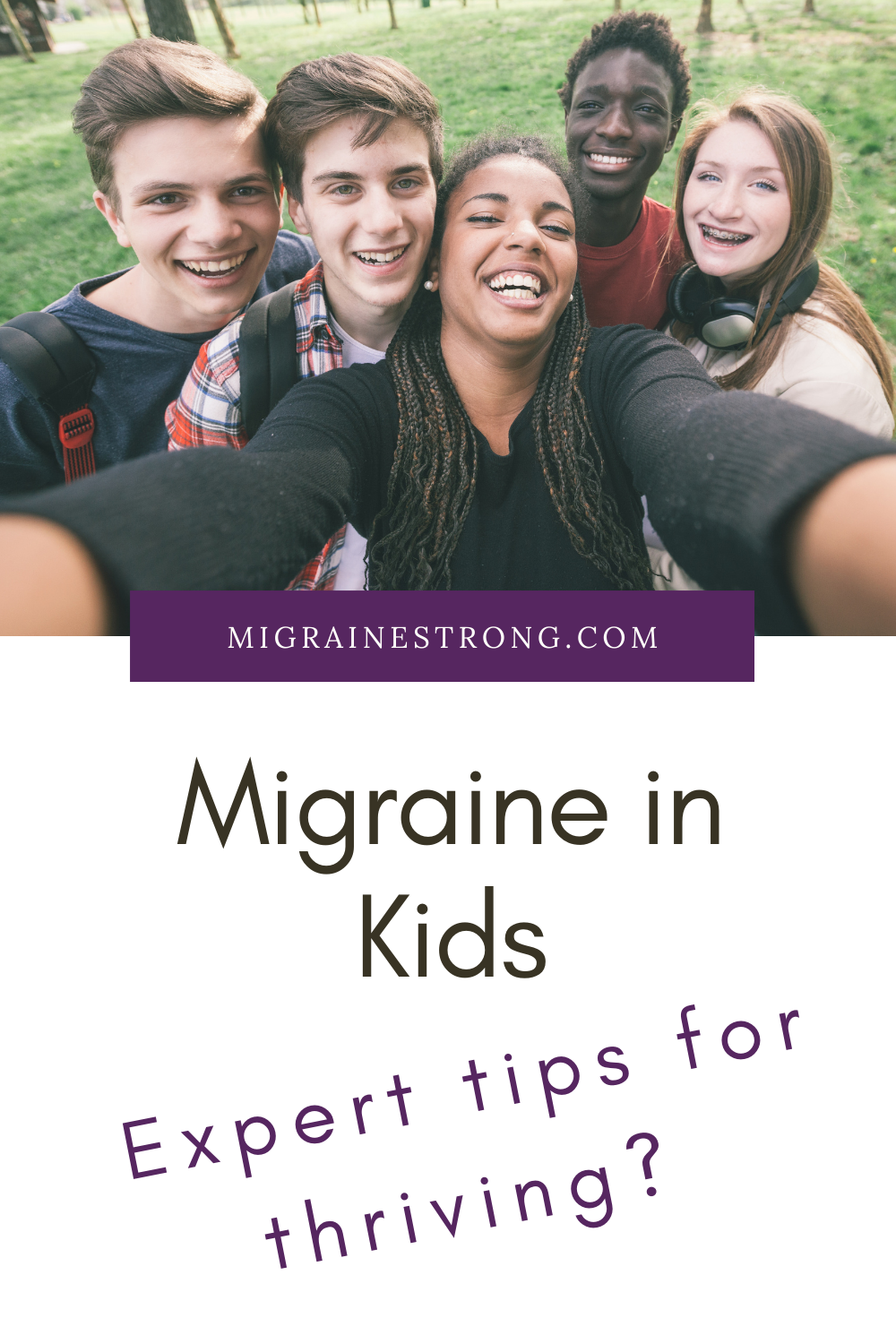Guest Post by Victoria E. Karian, RN, MSN, CPNP
Many adults with migraine had their first migraine attack as a child or teenager. In fact, headache and migraine are in the top 5 of medical concerns seen in pediatrician’s offices, with migraine being most common. Migraine often runs in families, so there is often familiarity and understanding about what a migraine is all about.
Often the first hurdle is recognizing that the problem is actually migraine. Sometimes it is obvious: severe headache pain with light and sound sensitivity, nausea and fatigue, relieved with medication and sleep.
**While Migraine Strong writes about the latest in migraine treatments, this is not medical advice. We are patient educators and all information you read should be discussed with your doctor.
Migraine in teens – Getting the diagnosis and knowing the variants
But sometimes pediatric migraine is hard to diagnose. Kids and teens can have different symptoms than adults, which can cause confusion. Many kids do not have an early warning system (aura or prodrome), or have not yet learned to recognize it. Migraine tends to be shorter in duration. The pain is often felt on both sides of the head or all over, compared to adults (pain is usually one-sided). They also have more gastrointestinal symptoms, like nausea, vomiting, abdominal pain, and diarrhea.
There are also migraine variants which are only seen in kids and teens, usually outgrown by adulthood. Kids with these variants may not experience headache pain at all. Instead, they might have severe abdominal pain or repeated episodes of vomiting or lose their balance/feel dizzy. As they grow older, what happens during migraine can change, with the variant symptoms receding and headache pain becoming more prominent. There is a lot to deal with if you are a teenager with migraine.
So how can teenagers live and actually thrive in these circumstances?
Teens can thrive with migraine if they learn as much as they can about:
- what triggers my migraines?
- what can I do to prevent migraine as much as possible?
Preventing migraine episodes is most important. This involves trying to figure out what triggers your migraine by personal observation and also the observation of those around you. Once you have an idea of the things in your life that can make a migraine happen, you try your best to avoid them. Keeping a diary, keeping notes in your phone calendar, or tracking using an app (Migraine Buddy for example), are all ways to get a handle on migraine management. It’s important to remember that everyone’s migraine episodes are different.
Try to notice changes in your mood or energy level. This may be a warning that a migraine attack is coming. Hopefully, that can help you minimize it.
Preventing migraine in teens with lifestyle
The most important factors in managing migraine for people of all ages involve lifestyle. The top 5 lifestyle recommendations are hydration, diet, sleep, exercise, and stress management. If you get a good handle on these items, then you will probably have fewer migraines. If you fall down on the job, migraine becomes more frequent. You cannot control everything, like the weather, but there are definitely things you can control, like hydration.
Hydration
This is probably the easiest thing to manage to prevent migraine. Basically you need to drink in ounces, the equivalent of half your weight in pounds (100lbs = 50 oz). Aim for this amount every day, and add more if you have a migraine, are exercising hard, or in the heat. Bring a refillable water bottle to school daily, and bring it home empty. Kids who drink during school generally meet their hydration goals and avoid those end of the school day headaches. Good choices include water, seltzer, electrolyte-rich fluids, milk, juice (in moderation), and not caffeinated beverages, or soda. Neither sugary nor sugar-free sodas are good choices and both are migraine triggers for some people.
Diet
When talking about diet, there are foods which can trigger migraine, foods that you don’t tolerate and trigger migraine, and foods which are generally unhealthy, full of additives and excessively processed, which are not good for anyone. Skipping meals can also trigger migraine. There are specific diets that can help figure out any food intolerances or sensitivities that make migraine more frequent. For teens, the best thing is to make sure to eat regularly, and do not go for long periods of time without eating.
Consult with a registered dietitian experienced in migraine if you are considering a more specific diet.
Sleep, teens and migraine – a special challenge
Getting enough sleep is crucial in the prevention of migraine. Both too little sleep and too much sleep are known to trigger migraine. Work hard to keep a regular schedule, even on weekends, which will really help avoid migraine (especially Monday morning migraine). Choices may need to be made about sleep-overs and sports/activities, and limits need to be put on electronics/phone use around bedtime. In our busy, over-scheduled lives, prioritizing sleep can be difficult, but it is so important.
Physical activity
Getting exercise on a regular basis is an excellent way to prevent migraines. It helps your body physically, reduces stress and releases endorphins, and can be a positive social experience. All of these aspects contribute to a healthier lifestyle with fewer migraines. The basic exercise recommendation is 30 minutes of vigorous activity, 3 times per week. This can be sports practice or games, dance class, going to the gym, or playing outside with the family dog. The best exercise is the one that you like and that you will actually do.
There are many kids who have figured out how to be a successful athlete with migraine and you can too.
Stress management
Stress is the #1 migraine trigger for people of all ages. Managing stress is an excellent way to reduce migraine frequency. Learning to ‘turn on the relaxation response’ is an intentional activity meant to induce real relaxation, turn down the mind chatter, and improve focus. There are lots of ways to do this, such as yoga, meditation, guided imagery, and breathing exercises. There are many ways to access these activities, such as working with a therapist, in a yoga class, or with YouTube videos. There are some great apps which can be helpful and give guidance (Calm, Headspace, Insight Timer). Teenagers often learn about this in a wellness/health class at school.
Having migraine as a teenager can certainly be difficult. Facing a lifelong pain condition is not easy no matter what your age. All the physical and emotional changes teenagers go through can often make everything more challenging. The key is to keep the migraine episodes infrequent. Most kids and teens have episodic rather than chronic migraine and the goal is to keep it that way as long as possible. By paying close attention to these lifestyle measures, migraine in teens can be minimized and teenagers can thrive.
Bio-
Victoria E. Karian, RN, MSN, CPNP, has been involved in pediatric medicine for the past 42 years, first as a staff nurse and, since 1996, as a pediatric nurse practitioner. She has worked in a wide variety of settings, in Boston, Miami, and in the US Peace Corps in Jamaica. For the past 10+ years, she has worked in both inpatient pediatric pain and now primarily outpatient headache management in the Multidisciplinary Pediatric Headache Program at Boston Children’s Hospital. She recently authored a resource book for pediatric primary care providers called, “Getting Ahead of Pediatric Headaches: A comprehensive guide for nurse practitioners to manage headaches in children and adolescents”.
Victoria is also a preceptor of PNPs through Northeastern University.
Promoting and providing health care for children and adolescents has been the focus and passion of her career. She has contributed to a variety of academic publications over the years. She started her blog in 2017, where she shares information and thoughts about caring for the pediatric population with chronic headaches. When not working, she engages in creative pursuits (singing, quilting, weaving), traveling the world, and kayaking.
Instagram: headfirstpnp
Facebook: @victoriakarian.author



